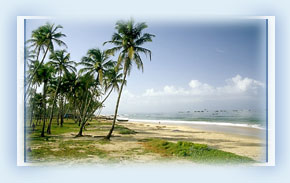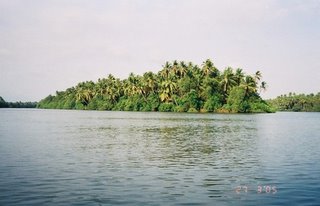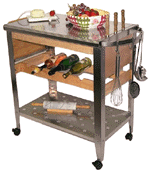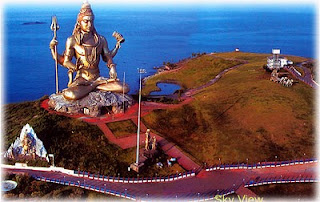
Gentle surf comes tumbling up to the shore and washes over your feet – your own foot bath. The water is clean and cooling. The boat is gliding towards me in a haze of mist. Polished wood slicing through water and making its way to where we are standing and the mists clear a bit, so I can see old Sheena’s face, a little more clearly. He is the fisherman who ferries passengers back and forth.
He spots us waiting on the stone pier and his sun-creased face breaks into a broad smile as he sees us waiting for our ride, as it were. We are his renegade visitors from Bombay whom he saw every year during the holidays. The boat washes up as close as possible to us but we wade out to greet it like the pros we have become after years of visiting grandma. Across from us is her island – a home that she’s known since she was 15 years old and came there as a wide-eyed bride. Her beautiful long hair had allegedly mesmerised my grandpa and that is how she came to be his blushing bride. He took her away to his private space – the island. Now in her 70s, she knows no other home.
We climb into the boat and the helpful kolis (fisherfolk) help with the luggage and then clamber on. They chat with my mother because they have known her since she was a little girl and know everything about her family. Deep, dark secrets don’t stay hidden on the island, they just become part of folk lore. These people have long memories and remember my generous great grandpa very well because he was something of a landed gentry here.
My great grandfather was able to feed his family off the fruits of the earth – literally. There was always a year’s supply of rice which was stored in round casks made of coir. This was lugged out of the attic as and when the stores in the kitchen diminished. Two people were needed to haul it down and the rice grains were fresh as ever and remained untouched by vermin. No state-of-the-art storage requirements needed here.
Fresh coconuts were plucked to be served to visitors. The sweet, cold taste of freshly sliced coconuts still tingles my tongue. Every part of the coconut is used – the coconut milk is like alchemy in fish gravies, the tender meat is for garnishing chicken masala or any of the seafood that was cooked. The husks were used to light the stove in the ancient kitchen. The dried palm fronds were made into mats and all weather coverings for windows and also made very versatile awnings over doorways.
Our family also had boats to give out to the fishing community and they paid us in kind. So, we had a succulent and fresh catches of the day delivered to our doorstep. My mother has never tasted better seafood anywhere else since. I call that being spoilt for choice!
The island approaches and we have to get off on a sandy bed because it is the dry time of the year. The luggage is merrily hoisted on many other shoulders apart from ours and people march on with it. They know exactly where to drop of it off and besides we need to keep our balance and not tumble into the water. But what they don’t know is that by then I’ve become almost like them. I can jump into boats and off them and wade through shifting sands in knee-deep water with a bag on my shoulder in skintight jeans. It’s the jeans which fools them. My mother worries that if I do tumble overboard, the heavy denim will drag me down and not keep me afloat. Oh mothers!
My grandmother is there now waiting for us at the top of the stone steps, cut into the side of the island in perfect symmetry. She knows we are here because the luggage got to her before we did. And the neighbours gather too for a warm welcome. My uncle climbs down to help us and we all walk into my grandma’s waiting arms.
We are all examined for damages, if any and then led through a coconut grove to the first yellow painted house. For years it was not called anything but the Christmas cards I sent always got there on time. Now it is named after my cousin – Marina Villa. The sand is soft and wet, bare feet sink as if on a luxurious Persian carpet. The sweet water well with the sign of the cross, which my great grandfather dug is there where it will always be – immovable. It’s got a cemented porch kind of area, where the neighbours come to sit and talk while taking turns at the pulley! This is where the gossip flows and plans are made. This is also where I’ve taken a cold shower plenty of times, especially after a hectic day on the beach, on the other side of the island. We avoid trailing sand into the house as much as possible because no one keeps their homes shut and therefore sand gets in anyway. But I’ve yet to see an unclean house or courtyard.
So after lazying around on the beach, I go to the well and clean off. I know how to work the pulley very well but my mother must have told them to keep me away from the edge in case I decide to take a better look inside! So the women keep pulling up pots of fresh water and pouring it over my head. On hot summer days, this is the closest you could get to nirvana.
The spirit of community is so great that people drop by to share meals without any formalities involved. There is always extras to go around. If there is a wedding, communion, confirmation or even a funeral, everyone pitches in to cook and help the family. Weddings especially can be fun because the ribbing and teasing starts long before the wedding night. With a houseful of relatives and neighbours, it's hard for the poor bride/groom to get away for a moment to themselves.
There was a time when, even wedding feasts were cooked at home entirely. I remember when my uncle and aunts got married, how the chicken dishes and idlis were made at home, in huge vats. This was possible because everyone showed up 2-3 days earlier and skinned chicken, diced vegetables, ground rice and masalas by hand. All this was accomplished by an efficient division of labour and done all through the night, accompanied by music and ribald jokes!
Men skinned, cleaned and cut meat - chicken, mutton, pork, while women ground spices and rice. All this was done in the huge open courtyard, often with kerosene lanterns and moonlight for company. I've been there and know what fun this is and what kind of camaraderie people shared. Now, ofcourse, the catered buffet has spread to Mangalore as well.
Most people enjoy Christian weddings because they serve alcohol, while other communities in India don't even serve non-vegetarian food. So, most children too sneak a sip or two of harder drinks that they would normally be forbidden. But it also goes without saying, that later on, alcoholism seems to strike many people - both men and women - though more men have fallen victim than women. Doing anything in a low-key manner is not an Indian tradition and drinking is one of them!

Here days begin early as cows have to be milked and then taken out to pasture and cowsheds cleaned. Then courtyards are swept energetically and water is fetched. Tea is prepared with hot dosas or idlis with tangy coconut chutney. Every meal is a rice-based gastronomic affair because that is the staple grain here. So you will never see chapatis being cooked in a traditional Mangalorean household. The same goes for urban breakfasts that consist upma, cornflakes, fruits etc. My grandma would think we were snacking on junk food! Fruits were always for after meals or if necessary in between meals if you were hungry. Farm fresh eggs from our own hens were always there and they tasted divine. Warm buns and loaves of new, succulent baked bread with just a hint of sweetness was always on the table because somebody always went across the river to the bakery before we kids even rolled over in our sleep.
Then everyone trooped out to the fields for the second time in the day before it got too hot to work. They returned around 11.00 am to have a mid-morning meal of thick brown rice stewed in its own water, some vegetables with grated coconut which was tasty in its simplicity, some home-made mango pickle and sun-dried jackfruit or chilli papads patiently made by an aunt over the summer months, just in time for us to descend in hordes and devour them. The brown rice would also be laced with ghee (clarified butter) got from our cows. My grandma would bring out this huge jar from her storeroom of delicious, yellow-coloured ghee and liberally pour it for everyone. I later learnt the secret to my grandma’s cooking – the taste was so phenomenal because she cooked everything in this pure ghee as opposed to vegetable oils bought from shops. My mother and aunts have inherited this habit from her. Only today, it is not unusual for my mother to come back from her trips to Mangalore with cans of pure coconut oil which is judiciously used over more than a year.
Everyone is so ecologically aware of how to use the resources around them to the maximum, there is a lesson here for us city folks. Coconuts would be taken across the river to the oil mill. The rice would also be milled across the river. Toddy, a fermented drink got from the coconut would be taken to the opposite side of the island, on the sea side because this is where the fisherfolk and the toddy tappers lived and they make toddy in huge vats over wood fires. Actual, freshly brewed toddy tastes like well, Irish coffee. That is the closest description I can think of. With just a taste of something other than coconut in the drink. Just like Baileys Irish cream never overwhelms the coffee but complements it.
The salty air does whip up an appetite and the days are spent lolling in the fields or going for boat rides around the island or chugging on a motorized launch with fishermen. These fishermen operate on the seaward side of the island and therefore they don’t upset the rhythm of my grandma’s or her neighbours’ households. The fishermen sometimes set out at night to do a spot of fishing and I’ve heard them sing as they mend their nets on the beach before setting out. With just paraffin wax lanterns lighting their way and the stars guiding them on their journey, the boats look like so many fireflies out on the water. With the river on one side (where Sheena’s ferry service operates), the paddy fields in between and the sea on the other side, this is Kodi – my private island in Mangalore, in every sense of the word.
Written for Jetwings
 Do you fancy a drink James Bond style - shaken and not stirred? Or want to imagine your on the deck of a luxury cruise ship drinking champagne? Sip it and meditate over the future or get nostalgic about the past. Either way, having a bar at home might appeal to your finer instincts and get your imagination going as well!
Do you fancy a drink James Bond style - shaken and not stirred? Or want to imagine your on the deck of a luxury cruise ship drinking champagne? Sip it and meditate over the future or get nostalgic about the past. Either way, having a bar at home might appeal to your finer instincts and get your imagination going as well! A trolley, the kind that some people use to wheel in breakfast- in-bed or on which they have snacks, while watching a movie at home with friends, well, this is just perfect to be wheeled around your apartment, as and when needed, and after use, it can be tucked in neatly into a corner.
A trolley, the kind that some people use to wheel in breakfast- in-bed or on which they have snacks, while watching a movie at home with friends, well, this is just perfect to be wheeled around your apartment, as and when needed, and after use, it can be tucked in neatly into a corner. Kushe has another option for people who don’t want to hunt for a carpenter and then shop for materials. She told moneycontrol, “Stores like Bombay Stores have readymade wine racks that are small enough to be put on a dining table or even a kitchen counter. This isn’t a bar but it serves the purpose of keeping your wine in an accessible place, rather than in the back of a cupboard.”
Kushe has another option for people who don’t want to hunt for a carpenter and then shop for materials. She told moneycontrol, “Stores like Bombay Stores have readymade wine racks that are small enough to be put on a dining table or even a kitchen counter. This isn’t a bar but it serves the purpose of keeping your wine in an accessible place, rather than in the back of a cupboard.”  Actually, that won’t be such a bad idea at all. Ofcourse, plan on spending a little more on keeping a well stocked selection of drinks. It doesn't have to be vintage wines or aged cognac because these don't come cheap. But all the same, there are Indian brands like Sula Wines and Indage, that are producing good white, red and sparkling wines. Buy your labels sensibly.
Actually, that won’t be such a bad idea at all. Ofcourse, plan on spending a little more on keeping a well stocked selection of drinks. It doesn't have to be vintage wines or aged cognac because these don't come cheap. But all the same, there are Indian brands like Sula Wines and Indage, that are producing good white, red and sparkling wines. Buy your labels sensibly.




 Apart from the splash of colours, the Sri Lankans are good at clever and innovative use of space. I passed by a little cottage abutting the main road in Kalutara, a small village on the way to Bentota (which is their premium beach area). I saw a man standing in a giant oval shaped photo frame! When I took a closer look, I realized that was his door. It had been cut into the stone exterior of his cottage in a perfect oval and the doorway was framed by wood trim that was painted a green colour.
Apart from the splash of colours, the Sri Lankans are good at clever and innovative use of space. I passed by a little cottage abutting the main road in Kalutara, a small village on the way to Bentota (which is their premium beach area). I saw a man standing in a giant oval shaped photo frame! When I took a closer look, I realized that was his door. It had been cut into the stone exterior of his cottage in a perfect oval and the doorway was framed by wood trim that was painted a green colour. 






